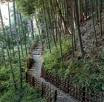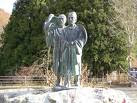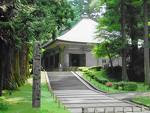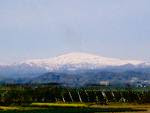[ . BACK to WORLDKIGO . TOP . ]
::::::::::::::::::::::::::::::::::::::::::::::::::::::::::::::::::::::::::::::::::::::::::::::::::::::::::::::::::::::::::::::::::::::::::::::::::::::::::::::::::::::::::::::::::::::::::::::::::::::::::::::
- Genjuuan Ki 幻住庵記 Genju-an Records -
the Hut of the Phantom Dwelling
Unreal Hut
Hut of the Unreal Dwelling
and its owner,
Suganuma Kyokusui 菅沼曲水

Basho stayed here after coming back from Oku no Hosomichi,
from Aprli 6 to July 23 in 1690
まづ頼む椎の木もあり夏木立
mazu tanomu shii no ki mo ari natsu kodachi
My temporary shelter,
a pasania tree is here, too,
in the summer grove.
Tr. by Peipei-Qiu
I don’t force myself to love idleness and solitude (kanjaku 閑寂), yet I am like a sick man who is weary of people, or a person who is tired of the world. How is it so? I have not led a clerical life, nor have I engaged in worldly undertakings; I am neither benevolent nor righteous. Ever since I was very young I have liked my eccentric ways, and once I made them the source of a livelihood, only temporarily I thought, I couldn’t put anything else in my mind and, incapable and talentless as I was, I have been bound to this single line of poetry.
In the poetry of Saigyô and Sôgi, the painting of Sesshû, and the tea of Rikyû, despite the differences of their talents, the fundamental principle is one. Without knowing, the autumn has half passed as I was pressing my back, rubbing my belly, and making a wry face. Human life is also like this, short as a brief dream. Again, I feel this must be what is meant by dwelling in unreality.
. yagate shinu keshiki mo miezu semi no koe .
It doesn’t look like
they will die in a short time—
the sounds of cicadas.
source : Basho-and-the-Dao - Peipei-Qiu
under construction
::::::::::::::::::::::::::::::::::::::::::::::::::::::::::::::::::::::::::::::::::::::::::::::::::::::::::::::::::::::::::::::::::::::::::::::::::::::::::::::::::::::::::::::::::::::::::::::::::::::::::::::
quote
Genjuan no ki
Beyond Ishiyama, with its back to Mount Iwama, is a hill called Kokub-uyama-the name I think derives from a kokubunji or government temple of long ago. If you cross the narrow stream that runs at the foot and climb the slope for three turnings of the road, some two hundred paces each, you come to a shrine of the god Hachiman. The object of worship is a statue of the Buddha Amida. This is the sort of thing that is greatly abhorred by the Yuiitsu school, though I regard it as admirable that, as the Ryobu assert, the Buddhas should dim their light and mingle with the dust in order to benefit the world. Ordinarily, few worshippers visit the shrine and it's very solemn and still. Beside it is an abandoned hut with a rush door. Brambles and bamboo grass overgrow the eaves, the roof leaks, the plaster has fallen from the walls, and foxes and badgers make their den there. It is called the Genjuan or Hut of the Phantom Dwelling. The owner was a monk, an uncle of the warrior Suganuma Kyokusui. It has been eight years since he lived there-nothing remains of him now but his name, Elder of the Phantom Dwelling.
I too gave up city life some ten years ago, and now I'm approaching fifty. I'm like a bagworm that's lost its bag, a snail without its shell. I've tanned my face in the hot sun of Kisakata in Ou, and bruised my heels on the rough beaches of the northern sea, where tall dunes make walking so hard. And now this year here I am drifting by the waves of Lake Biwa. The grebe attaches its floating nest to a single strand of reed, counting on the reed to keep it from washing away in the current. With a similar thought, I mended the thatch on the eaves of the hut, patched up the gaps in the fence, and at the beginning of the fourth month, the first month of summer, moved in for what I thought would be no more than a brief stay. Now, though, I'm beginning to wonder if I'll ever want to leave.
Spring is over, but I can tell it hasn't been gone for long. Azaleas continue in bloom, wild wisteria hangs from the pine trees, and a cuckoo now and then passes by. I even have greetings from the jays, and woodpeckers that peck at things, though I don't really mind-in fact, I rather enjoy them. I feel as though my spirit had raced off to China to view the scenery in Wu or Chu, or as though I were standing beside the lovely Xiao and Xiang rivers or Lake Dongting. The mountain rises behind me to the southwest and the nearest houses are a good distance away. Fragrant southern breezes blow down from the mountain tops, and north winds, dampened by the lake, are cool. I have Mount Hie and the tall peak of Hira, and this side of them the pines of Karasaki veiled in mist, as well as a castle, a bridge, and boats fishing on the lake. I hear the voice of the woodsman making his way to Mount Kasatori, and the songs of the seedling planters in the little rice paddies at the foot of the hill. Fireflies weave through the air in the dusk of evening, clapper rails tap out their notes-there's surely no lack of beautiful scenes. Among them is Mikamiyama, which is shaped rather like Mount Fuji and reminds me of my old house in Musashino, while Mount Tanakami sets me to counting all the poets of ancient times who are associated with it.
Other mountains include Bamboo Grass Crest, Thousand Yard Summit, and Skirt Waist. There's Black Ford village, where the foliage is so dense and dark, and the men who tend their fish weirs, looking exactly as they're described in the Man'yoshu. In order to get a better view all around, I've climbed up on the height behind my hut, rigged a platform among the pines, and furnished it with a round straw mat. I call it the Monkey's Perch. I'm not in a class with those Chinese eccentrics Xu Quan, who made himself a nest up in a cherry-apple tree where he could do his drinking, or Old Man Wang, who built his retreat on Secretary Peak. I'm just a mountain dweller, sleepy by nature, who has turned his footsteps to the steep slopes and sits here in the empty hills catching lice and smashing them.
Sometimes, when I'm in an energetic mood, I draw clear water from the valley and cook myself a meal. I have only the drip drip of the spring to relieve my loneliness, but with my one little stove, things are anything but cluttered. The man who lived here before was truly lofty in mind and did not bother with any elaborate construction. Outside of the one room where the Buddha image is kept, there is only a little place designed to store bedding.
An eminent monk of Mount Kora in Tsukushi, the son of a certain Kai of the Kamo Shrine, recently journeyed to Kyoto, and I got someone to ask him if he would write a plaque for me. He readily agreed, dipped his brush, and wrote the three characters Gen-ju-an. He sent me the plaque, and I keep it as a memorial of my grass hut. Mountain home, traveler's rest-call it what you will, it's hardly the kind of place where you need any great store of belongings. A cypress bark hat from Kiso, a sedge rain cape from Koshi-that's all that hang on the post above my pillow. In the daytime, I'm once in a while diverted by people who stop to visit. The old man who takes care of the shrine or the men from the village come and tell me about the wild boar who's been eating the rice plants, the rabbits that are getting at the bean patches, tales of farm matters that are all quite new to me. And when the sun has begun to sink behind the rim of the hills, I sit quietly in the evening waiting for the moon so I may have my shadow for company, or light a lamp and discuss right and wrong with my silhouette.
But when all has been said, I'm not really the kind who is so completely enamored of solitude that he must hide every trace of himself away in the mountains and wilds. It's just that, troubled by frequent illness and weary of dealing with people, I've come to dislike society. Again and again I think of the mistakes I've made in my clumsiness over the course of the years. There was a time when I envied those who had government offices or impressive domains, and on another occasion I considered entering the precincts of the Buddha and the teaching rooms of the patriarchs. Instead, I've worn out my body in journeys that are as aimless as the winds and clouds, and expended my feelings on flowers and birds. But somehow I've been able to make a living this way, and so in the end, unskilled and talentless as I am, I give myself wholly to this one concern, poetry. Bo Juyi worked so hard at it that he almost ruined his five vital organs, and Du Fu grew lean and emaciated because of it. As far as intelligence or the quality of our writings go, I can never compare to such men. And yet we all in the end live, do we not, in a phantom dwelling?
But enough of that-I'm off to bed.
Among these summer trees,
a pasania-
something to count on
From the Country of Eight Islands. New York: Columbia University Press, 1960. - tr. by Nobuyuki Yuasa
source : terebess.hu
::::::::::::::::::::::::::::::::::::::::::::::::::::::::::::::::::::::::::::::::::::::::::::::::::::::::::::::::::::::::::::::::::::::::::::::::::::::::::::::::::::::::::::::::::::::::::::::::::::::::::::::
quote
Genjuan no Ki: Basho's Phantom Hut
Matsuo Basho (1644-1694) is best known for standardizing the formula and art of the haiku in Japanese poetry, which he mastered. His haiku are read as individual poems, though he wrote them in the context of several travel journals as an itinerant influenced by Zen Buddhist philosophy in a culture that intensely valued literary expression.
Basho's wry and personable journals include Journals of a Weather-Beaten Skeleton, Notes in My Knapsack, and Narrow Road to the Far North. But perhaps his most famous travel piece is a brief narrative of his last dwelling place, Genjuan no Fu, translated by Burton Watson as "Record of the Hut of the Phantom," and by Donald Keene more evocatively as "The Unreal Dwelling."
Like Chomei before him, Basho's piece is the work of a world-weary observer of vanity, pretension, and human folly. He is sensitive to nature and the cycle of the seasons, honest and content with himself. There is no hint of a tumultuous life or a bitter maturity. The refreshing candor of Basho is not mingled with the social commentary of Chomei.
My body, now close to fifty years of age, has become an old tree that bears bitter peaches, a snail which has lost its shell, a bagworm separated from its bag. It drifts with the winds and clouds that know no destination.
This formulaic modesty, necessary for the cultivator of solitude, opens the narrative , quickly followed by a description of the hut where he now lives. The little thatched dwelling is perched on a mountainside next to an old shrine "which so purifies my senses that I feel cleansed of the dust of the world."
The hut was the retreat of a warrior who likewise had abandoned the world years before, and now the hut stands abandoned "at the crossroads of unreality."
The stands in an idyllic setting between two mountains, as Basho elaborates:
From the lofty peaks descends a fragrant wind from the south, and the northern wind steeped in the distant sea is cool. It was the beginning of the fourth moon when I arrived, and the azaleas were still blossoming. Mountain wisteria hung on the pines. Cuckoos frequently flew past, and there were visits from the swallows.
Basho compares the view to a scene from China. He can see lofty pine forest shrouded in mist and can glimpse a castle. One mountain reminds him of Fuji and an old cottage in which he once lived. On the other mountain, Basho constructed a look-out he calls a monkey perch, where he can spread out a straw mat and enjoy a spectacular view -- and pick lice.
Simplicity, even austerity, are hallmarks of the Japanese Zen hermits, and Basho is pleased that the former occupant of the hut had "most refined tastes and did not clutter up the hut even with objects of art." The hut is a single room with a niche for a household shrine and another for hanging nightclothes. A plaque over the latter niche describes the hut in a single brushstroke: "Unreal Dwelling."
Having lived an itinerant life in the company of other like-minded poets, Basho still enjoys a little socializing. Of course, the villagers are farmers, not poets. They talk of rice planting and rabbits in their plots, and a noisome boar. When more sophisticated visitors find him the night is passed in quiet conversation, moon-watching.
Basho has no regrets for past mistakes - chasing after government office in his youth, not having become a formal Zen monk when he had the chance, or thinking he could match the two great Chinese poets, Po Chu-i and Tu Fu, who shaped his own sensibilities.
In this hut where I live as a hermit, as a passing traveler, there is no need to accumulate household possessions. ... But I should not have it though from what I have said that I am devoted to solitude and seek only to hide my traces in the wilderness. Rather, I a m like a sick man weary of people, or someone who is tired of the world.. What is there to say? ... I labor without results, am worn of spirit and wrinkled of brow. Now, when autumn is half over, and every morning and each evening brings changes to the scene, I wonder if that is not what is meant by dwelling in unreality. And here too I end my words.
What more is there to say? The characteristic self-effacement of Japan's greatest poets testifies to his simple wisdom: that we all, at every moment of our lives, are dwelling in a phantom hut, an unreal dwelling. He leaves us a haiku, though not his last one, for he dies (at fifty) four years later)....
Among these summer trees,
a pasania --
something to count on.
(The pasania is a majestic and ancient tree with spreading trunk and splendid canopy, hence "something to count on.")
source : www.hermitary.com
::::::::::::::::::::::::::::::::::::::::::::::::::::::::::::::::::::::::::::::::::::::::::::::::::::::::::::::::::::::::::::::::::::::::::::::::::::::::::::::::::::::::::::::::::::::::::::::::::::::::::::::
An Authentic Portrait of Bashō (Bashō Shōzō Shinseki)
Painted by Watanabe Kazan
source : tokyo metropolitan museum
::::::::::::::::::::::::::::::::::::::::::::::::::::::::::::::::::::::::::::::::::::::::::::::::::::::::::::::::::::::::::::::::::::::::::::::::::::::::::::::::::::::::::::::::::::::::::::::::::::::::::::::
quote
In Search of the Plum’s Fragrance
(A Brief Examination of Hermitage Literature)
by Marjorie A Buettner
. . . . .
... Sometimes this idea of a hermetic life becomes a permanent way of living: “my heart in middle age found the way, / and I came to dwell at the foot of this mountain.” (Wang Wei (699-759) Basho (1644-1694), inspired no doubt by Saigyo (1118-1190), had many huts throughout the end of his life: “The Basho Hut” (1680-83), the “Unreal Hut” or “Hut of the Phantom Dwelling” (1690) near Lake Biwa, and additionally the “House of Fallen Persimmons” 1691, (a country house of his disciple Mukai Kyorai in Saga where he wrote The Saga Diaries and The Monkey’s Cloak). In 1692 Basho returned finally to the newly rebuilt hut by the Sumida River after the original one burned down. Basho craved that thatched hut on a mountain side “which so purifies my senses that I feel cleansed of the dust of the world.” (from Records of the Hut of the Phantom Dwelling) When cleansed of the dust of the world the poet is then able to attune himself to the universe:
... And even though Basho compares his “phantom hut” to the nest of the grebe (a water bird that attaches its floating home to a reed so that it will not be washed away), the hermit-poet adapts, survives, and thrives knowing that all of our huts, all of our homes are built of the same fragile material, the same material of which dreams are made.
“In this hut where I live as a hermit, as a passing traveler, there is no need to accumulate household possessions . . . But I should not have it though from what I have said that I am devoted to solitude and seek only to hide my traces in the wilderness. Rather, I am like a sick man weary of people, or someone who is tired of the world. What is there to say? I labor without results, am worn of spirit and wrinkled of brow. Now, when autumn is half over, and every morning and each evening brings changes to the scene, I wonder if that is not what is meant by dwelling in unreality. And here too I end my words.”
(Basho from Record of the Hut of the Phantom Dwelling)
source : Simply Haiku 2012
::::::::::::::::::::::::::::::::::::::::::::::::::::::::::::::::::::::::::::::::::::::::::::::::::::::::::::::::::::::::::::::::::::::::::::::::::::::::::::::::::::::::::::::::::::::::::::::::::::::::::::::
夏草や我先達ちて蛇狩らん
natsukusa ya ware sakidachite hebi karan
summer grass -
I will go first
and hunt for snakes
Tr. Gabi Greve
Written in 1690 元禄3年4月16日
Snakes were a common sight at the hermitage. Basho is inviting a friend to come and have a look. Basho is sure to catch a snake or two in the grass to boast with his catch.
A hokku with a light touch.
On the same day, he also wrote the following:
夏草に富貴を飾れ蛇の衣
natsukusa ni fuuki o kazare hebi no kinu
in the summer grass
what a precious decoration -
the skin of a snake
Tr. Gabi Greve
This time Basho was lucky to find the skin of a snake in the grass.
. WKD : snake skin, hebi no kinu 蛇の衣 .
kigo for early summer

::::::::::::::::::::::::::::::::::::::::::::::::::::::::::::::::::::::::::::::::::::::::::::::::::::::::::::::::::::::::::::::::::::::::::::::::::::::::::::::::::::::::::::::::::::::::::::::::::::::::::::::
「石山の奥、岩間のうしろに山あり、国分山といふ」
quote
... It is called Genjuan, or Hut of the Phantom Dwelling.
The owner was a monk, an uncle of the warrior
Suganuma Kyokusui.
It has been eight years since he lived there - nothing remains of him now but his name, Elder of the Phantom Dwelling.
Tr. Haruo Shirane
source : books.google.co.jp
::::::::::::::::::::::::::::::::::::::::::::::::::::::::::::::::::::::::::::::::::::::::::::::::::::::::::::::::::::::::::::::::::::::::::::::::::::::::::::::::::::::::::::::::::::::::::::::::::::::::::::::
Suganuma Kyokusui 菅沼曲水
had offered the 幻住庵 Genju-An to Basho, in the name of 勇士曲水.
His name is also written 曲翠. also 外記, 馬指堂
His exact dates are not known. ~享保二年(? - 1717)
or 享保2年7月20日 (1659 - 1717)
His name was 菅沼定常,, an official of the Zeze domaine 膳所藩 in Omi.
He became a disciple of Basho during one of his stays in Edo.
The Genju-An was the hermitage of his grandfather, 菅沼修理定知.
In 1717 he killed the chief senior retainer of his domaine, Soga Gondayu 曽我権太夫, because Gondayu had been dishonest with the domaine affairs, but was difficult to bring to trial.
So Kyokusui killed him (without official trial) with one hit of his spear.
To attone for this deed, he then commited
seppuku suicide himself.
His grave is at the temple 義仲寺 Gichu-Ji.

When Kyokusui was out of town on domaine business, his younger brother Dosui took good care of Master Basho.
. Takahashi Dosui 高橋怒誰 .
(? - 1743)
. Basho and - Gichuuji 義仲寺 Temple Gichu-Ji - .
....................................................................................................................................................
To thank his host for a barrel of sake to celebrate the New Year,
Matsuo Basho wrote
なかなかに心をかしき臘月哉
naka naka ni kokoro okashiki shiwasu kana
here and now
I feel quite at ease -
Twelfth Month
shiwasu 師走 - The Japanese is a pun on SHI HASU 師走, calling the monks together to read the sutras for the End of the Year.
In the last month of the year, everyone is usually busy with preparations, but Basho is quite comfortable in his lodging.
Written in 1692, Genroku 元禄5年12月
. WKD : December, "end of year month", shiwasu 師走 (しわす) .
roogetsu 臘月(ろうげつ)"month holding the years together"
MORE - about - kokoro こころ - 心 "heart", mind, soul -
. Matsuo Basho 松尾芭蕉 - Archives of the WKD .
....................................................................................................................... .............................
埋火や壁には客の影法師
uzumi-bi ya kabe ni wa kyaku no kagebooshi
banked charcoal—
against the wall,
the guest’s shadow
Tr. Barnhill
MORE - about charcoal and discussion about this poem -
Another explanation is a visit by his friend Kyokusui 曲水 and both of them sit around the fireplace.
In this case the kage shadow is Kyokusui's.
. Matsuo Basho 松尾芭蕉 - Archives of the WKD .
::::::::::::::::::::::::::::::::::::::::::::::::::::::::::::::::::::::::::::::::::::::::::::::::::::::::::::::::::::::::::::::::::::::::::::::::::::::::::::::::::::::::::::::::::::::::::::::::::::::::::::::
. - Suganuma Gon-emon 菅沼権右衛門 - Koogetsu 菅沼耕月 Kogetsu - .
. Matsuo Basho Travelling 松尾芭蕉 .
[ . BACK to DARUMA MUSEUM TOP . ]
[ . BACK to WORLDKIGO . TOP . ]
::::::::::::::::::::::::::::::::::::::::::::::::::::::::::::::::::::::::::::::::::::::::::::::::::::::::::::::::::::::::::::::::::::::::::::::::::::::::::::::::::::::::::::::::::::::::::::::::::::::::::::::


































